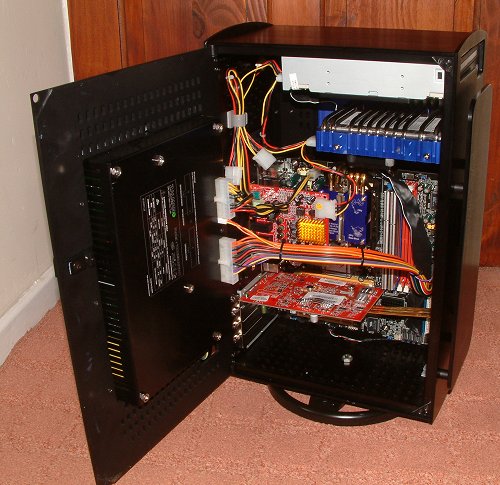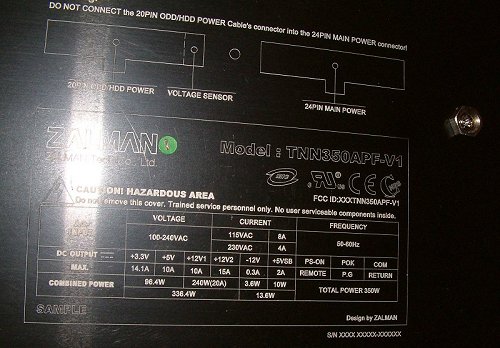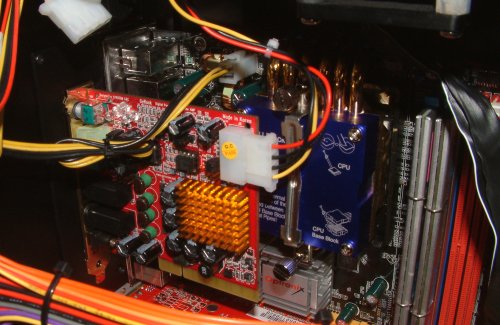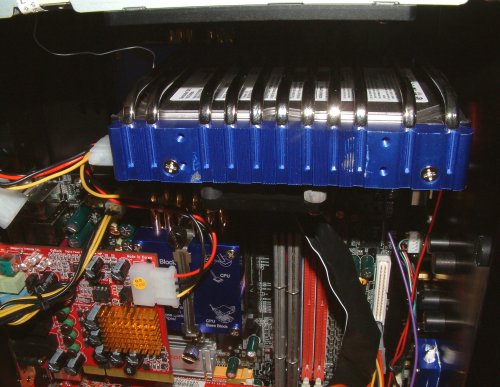How is it all put together?

The TNN 300's internal are accessed by pulling down a latch on the left-hand side. What you'll see inside is obviously dependant on how the chassis has been configured, if at all.

The chassis' integrated, fanless PSU is mounted on the left-hand side and, as expected, the heat produced is also exhausted from this side, via the external fins shown on the previous page. Whilst being totally passive in design, the PSU is rated to nominal 350W, which is more than enough power (and, as it happens, quality) to run the components on the right.
The TNN 300's small-ish external dimensions and, by inference, less cooling ability than the TNN 500, limits the chassis to cooling CPUs that generate <70W TDP. Depending upon the micro-ATX-sized motherboard used, you can have the TNN 300 configured to use either Intel's S478 (Celeron and Pentium 4, up to 2.8GHz clock speed) or AMD's S754/S939 CPUs, ranging up to a maximum 2.2GHz clock speed, so no X2 4800s or Pentium 4 3.73GHz Extreme Editions, we're afraid.

You can see the copper CPU block and its 6 heatpipes in the background of the above picture, right behind the stereo digital amplifier card which offers up to 25W per channel, allowing you to plug your speakers right in. What you can also see, we hope, is that the TNN 300 is very much a fix-and-forget kind of installation. Accessing components, once fixed into position and with blocks in contact with the chassis, is a wholly cumbersome affair. Changing the CPU, for example, is a time-consuming process that requires careful removal of the heatpipe-driven block. The same is true for the graphics card. Upgrading, then, is obviously more problematic than in a regular case. Quiet PC assembled the review sample with a S939 Athlon 64 3500+ (Winchester-based) CPU.

The drive for totally fanless running necessitates the need for a passively cooled graphics card. Quiet PC opts for a 425/864MHz-clocked RADEON X700 PRO 256MB; a card firmly entrenched in the midrange sector. The aluminium VGA block, Zalman says, can transfer up to 75W of heat away from the card. The heatpipes extend to the chassis, where it is then convected to the outside. We wonder if a faster graphics card could have been used. GeCube, for example, has recently introduced a silent, heatpipe-driven RADEON X800 XL 512MB that would, we imagine, would work well here.

No system that uses a regular hard drive is going to be completely silent. Quiet PC has done its best to reduce the heat, and some extent noise through a lack of drive vibration, produced by a Seagate 250GB SATA drive. The drive cage acts like another heatsink, replete with yet more heatpipes. Quiet PC realises that having the rest of the system run with practically no noise means that any noise-making peripherals, no matter how quiet, will sound obtrusively loud.
The design does what it sets out to do, that is, deliver midrange PC performance with literally no noise. Switching on the TNN 300 is interesting in itself. You have to either look at the power activity LED or place your ear right next to the chassis to confirm that the system is actually switched on. We're adamant that from 2 feet away you absolutely cannot tell if the system is working or in standby/off mode. If silence is golden, the Quiet PC/TNN 300 combination is 24-carat material.









